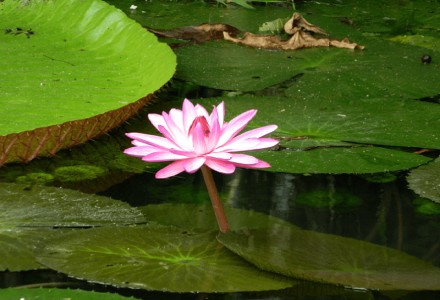
Victoria amazonica Facts
- The descriptive term of Victoria amazonica represents the scientific name of a beautiful and truly impressive flowering plant. For the moment, though, this truly marvelous work of Nature unfortunately has no generally accepted common name.
- The physically amazing flora further forms a member of the magnificent Nymphaeaceae Family, in scientific classification. Not only that, but this incredible plant also currently represents the largest member of the amazing group of plants.
- Both this individual species itself, and indeed the entire Family, in fact, share one uniquely impressive statistic. Quite amazingly to some people, both were named in honor of the late Queen Victoria, of England, in the year 1837.
- This honorary naming occurred subsequent to the first official publication of a description of the plant, by the renowned John Lindley. The French botanist Aimé Bonpland, though, made an unofficial description of it earlier, in 1825.
- Quite fortunately, for the moment, the gorgeous Victoria amazonica does not appear on the IUCN published Red List of Threatened Species. The visually amazing plant nevertheless still remains considered by many to be at some risk.
- This regrettable condition holds true due to a variety of factors. For one thing, the rapid deforestation of the region may soon threaten the species. Its greatest threat, though, no doubt comes in the form of the ongoing effects of climate change.
Related Articles
Snowdrop Chinese Lantern Orpheus Flower
Victoria amazonica Physical Description
In addition to everything else, the Victoria amazonica stands out from its many related species in one spectacular manner; its sheer size. This plant is the largest known member of its Family. The pads of this Angiosperm attain an average diameter of roughly 10 ft (3 m).
These remarkable portions of the fascinating beautiful plants also develop attached to incredible underwater stalks. In an astounding accomplishment of evolution, these components of the plant themselves sometimes reach up to a startling 26 ft (8 m) in length.
The surprisingly gorgeous blooms of the awesome Victoria amazonica themselves also deserve notice. These blossoms typically reach a diameter measuring about 15.75 in (40 cm), and appear as white on their first day, then change to pink afterwards.
The underside of the leaves shows a stunning purplish-red color, and also develops covered in numerous sharp spines. The upturned edges further add to its buoyancy. If evenly distributed, a single leaf can also support as much as 100 lb (45 kg).
- Kingdom: Plantae
- Phylum: Tracheophytes
- Class: Angiosperms
- Order: Nymphaeales
- Family: Nymphaeaceae
- Genus: Victoria
- Species: V. amazonica
Victoria amazonica Distribution, Habitat, and Ecology
Quite surprisingly, the visually stunning and scientifically fascinating Victoria amazonica inhabits a comparatively large section of the globe. Within that enormous overall zone of habitation, however, the distinctive Angiosperm only appears in a highly specific region.
Not surprisingly, as its name alludes to, this marvel of Nature only grows naturally in the Amazon River Basin in central and eastern South America. Even within this geographically large region, the Angiosperm has very specific needs for its choice of habitat.
It evolved to prosper in regions of shallow, slow-moving waters. Consequently, within its range, it appears almost exclusively in areas mostly consisting of bayous and oxbow lakes. A significantly smaller percentage of specimens appear in small swamps, though.
Fortunately, the beautiful Victoria amazonica also evolved as quite versatile in some aspects of its physiology. That’s because this plant achieves the vast majority of its pollination via the actions of the numerous varieties and numbers of beetles native to its range.
To take maximum advantage of this resource, a single plant can produce as many as 50 of these gargantuan pads. The growth rate of these features also leaves one astonished, because each of these leaves grows as much as 6 in (15 cm) per day.
Species Sharing Its Range
Check out our other articles on 7 Supremely Scintillating Cnidaria, Pesquet’s Parrot, Gocta Cataracts, Bleeding Tooth Fungus, Dall’s Porpoise, Rainbow Grasshopper, Mountain Chicken

